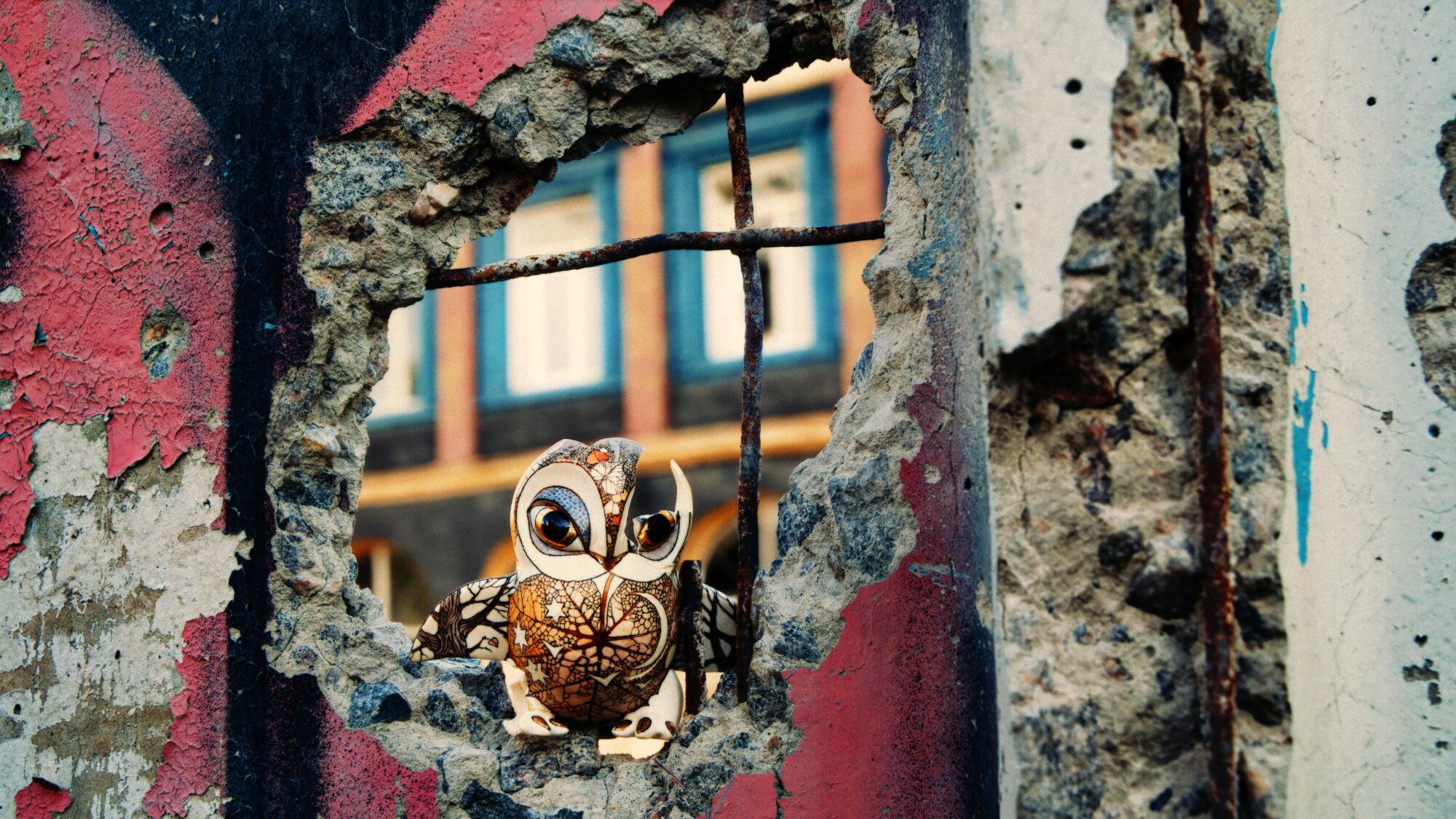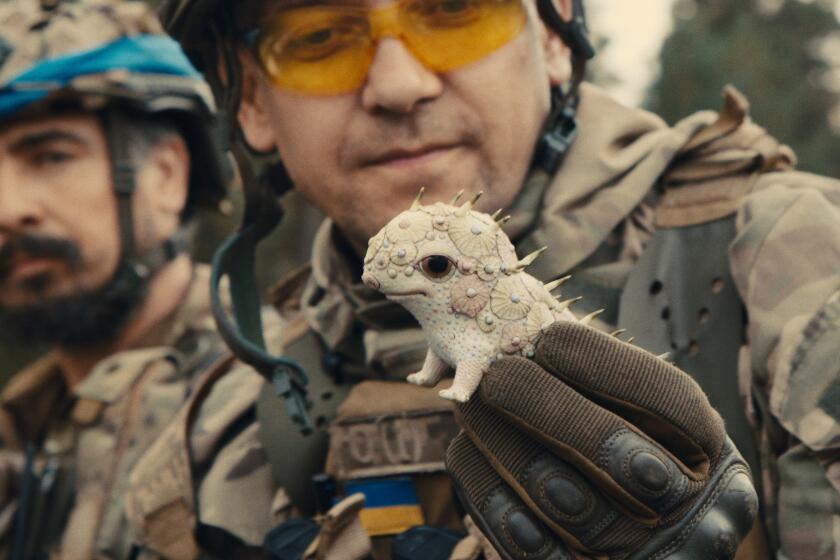
- Share via
Art mobilizes against bullets, bombs and tanks in “Porcelain War,” a documentary about how beauty not only persists amid the wreckage of warfare but serves as a necessary existential weapon of its own. The film, which won the U.S. grand jury prize for documentary at the 2024 Sundance Film Festival, is competing for an Academy Award — drawing never-more-urgent focus to the Ukrainian fight against invading Russian forces.
It’s the third year in a row that a documentary about Ukraine has been nominated, with “20 Days in Mariupol” winning the Oscar last year. But as the title suggests, this one hits differently. Its subjects are a couple — ceramicist Slava Leontyev and Anya Stasenko, who evocatively paints his palm-size creatures — and another painter, their friend Andrey Stefanov. When Russian attacks escalated in February 2022, their lives were turned upside down: Leontyev and Stasenko fled their Crimean home for Kharkiv, near the Russian border in northeast Ukraine, while Stefanov apprehensively sent his wife and two daughters out of the country for their safety.
The men took different roles as Ukrainian civilians donned camouflage to join the fight: Leontyev became a weapons instructor and Stefanov swapped his paintbrushes for a camera. Both began documenting their lives, in and out of strife, as co-director and cinematographer, respectively, of this film. The project, however, had peacetime roots: Polish-born producer Aniela Sidorska and American co-director Brendan Bellomo had originally hoped to collaborate on an animation project around Stasenko and Leontyev’s folkloric miniatures. The war changed that.
“Slava really felt that while there were so many Western journalists that were telling an important perspective, it was from the outside,” Bellomo says, “and he really had this personal story to tell, to really try to complete that picture. And so we wanted to empower them to share this.”

With the help of a volunteer network, the production was able to set up various members of Leontyev’s unit with GoPro body cams, camera drones and compact cinema cameras with which they shot more than 500 hours of footage. “They would go down into a bunker during their missions and, on Starlink video, we would have a small class,” says Bellomo, who taught them essential filmmaking grammar. “They’re contractors, they’re IT professionals, doctors. They’re furniture salespeople. They’re not professional soldiers. They don’t want to fight a minute longer than they have to, but they’ve taught themselves to prepare for this war, and they felt they could teach themselves how to turn on a camera amidst battle.”
Due to that process, “Porcelain War” features unique angles on 21st century combat, as camera drones observe armed drones while they hover above a bomb target. Meanwhile, the synchronized body cameras capture multiple perspectives of soldiers working together on the ground. “There’s an incredibly deep, almost irony to the way that they’re looking at their situation,” says Bellomo, who recently joined Leontyev for a video conversation.
A prize-winner at this year’s Sundance Film Festival, the documentary is a unique window into the personal nature of the war in Ukraine, not just over territory.
The endeavor also proved an emotional boost for the soldiers in the unit, which they call “Saigon” in honor of “Apocalypse Now,” a collective favorite. “It’s really important for them to make something normal during the war,” Leontyev says. At one point, his commander eased the artist’s doubts about shooting video instead of bullets. “She answered me, ‘Now you have a more powerful and more impactful weapon: your camera.’ Personally, I never thought about the camera like a weapon. For me, it was a new brush for paint. But it’s really the same, because the totalitarian government is trying to take away our free choice, how to think and how to create.”
The narrative is paced by startling juxtapositions between the carnage of destroyed villages and the peaceful natural beauty of the nearby countryside.
Perhaps the boldest contrast, though, is how a walk through the woods can lead both to a trove of porcini mushrooms (dutifully collected for the soldiers) and a land mine (which Leontyev defuses with an unhurried hand). “You need to keep calm,” he says. “It’s a way to survive.”
It’s the kind of spirit that made such a complicated and risky production possible. “There’s this Ukrainian attitude of, ‘We’re going to figure it out,’” Bellomo says. “We’re going to figure it out together.”
Happily, aspects of the planned animation project carried through, with mesmerizing sequences created by the Polish studio BluBlu, accompanied by the keening melodies of Ukrainian ethnic fusion quartet DakhaBrakha, which donated its catalog for the production to use as it pleased.
“It’s natural for us as artists to try to look around, to try to find something interesting and something beautiful,” Leontyev says. “Animation gave us the opportunity to tell about the terrors of war without showing them like the news does, because news gets old. And we filmed every flower or every river or every person as if it was the last day they exist.”
More to Read
From the Oscars to the Emmys.
Get the Envelope newsletter for exclusive awards season coverage, behind-the-scenes stories from the Envelope podcast and columnist Glenn Whipp’s must-read analysis.
You may occasionally receive promotional content from the Los Angeles Times.











